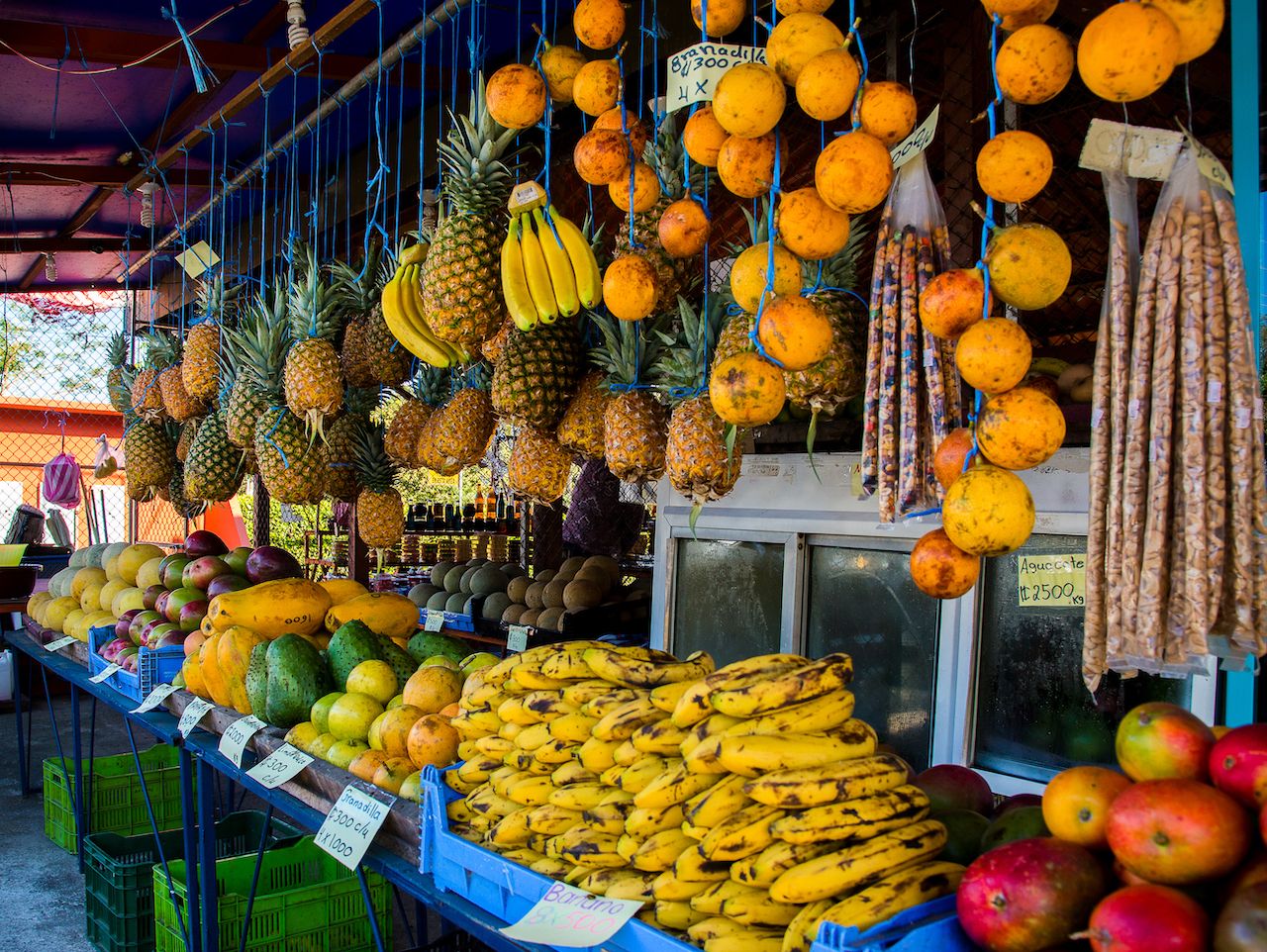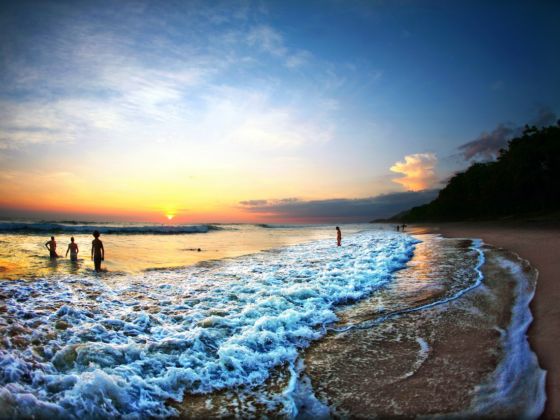You may have heard travelers you know refer to Costa Rica as their little “corner of Eden.” If you’ve been here before, you get it, and if you haven’t, you will. This place is 100% real and as fresh as as it gets — even if you’re a veteran visitor, the next time you cross these borders you’ll meet new people, conquer new adventures, encounter new wildlife, and maybe come back more than a little renewed yourself.
Though the list is always growing, check out these 10 surefire ways to elevate your trip to the appropriately christened land of pura vida.
1. Taking your time to travel overland
Once you arrive in Costa Rica, likely via San José’s international airport, it can be easy to assume you’re supposed to charter a van or hop on a puddle jumper to beam straight to your ultimate destination. Don’t do it! If you want to get a true feel for these verdant landscapes, for the valleys perfumed with pineapple and orchid, for the views that stretch to the ocean and beyond, then you must, must, must travel slowly, overland.
It’s simple: Rent your own car (4×4 recommended for the adventurous), get a GPS, and go. There’s no better way to get to know a place than tracing its lines from behind the steering wheel. Not to mention, you’ll meet some amazing people on the road, and you’ll form more lasting memories taking the not-so-trodden path.
2. Letting loose your taste buds in Barrio Escalante, the “Brooklyn of Chepe”
Not that every new, hip place in Barrio Escalante is trying to be Brooklyn, but this analogy will give you the gist of what to expect — though with a decidedly tico twist. In this district of San José, creatives sip coffee (most likely much better than what Brooklyn has to offer), artsy holes-in-the-wall sell mind-blowing originals, and the food and microbrews are redefining the culinary scene of the entire country.
So when you land in San José, don’t rush out. Take it in. The beaches will still be there when you need them.
3. Wandering San José’s Mercado Central

Photo: Jorge A. Russell/Shutterstock
For a true cultural introduction to Ticolandia, a good primer is to visit the Mercado Central in downtown San José. You’ll find anything from fresh organic produce to traditional clothing to an ice cream shop that survived off selling a single flavor (a mix of vanilla, cinnamon, and other secret spices) for over 100 years. What’s more, you’ll get a veritable history lesson if you take the time to peruse the many alleys and rabbit trails of this merchant labyrinth.
Don’t forget to take a seat (or really, a stool) at one of the many food vendors. Clues as to the best food will be boisterous crowds and a fired-up kitchen — this means the food is reliable, and you won’t have to wait for the cooks to get set up. If nothing else, I highly recommend a café con leche or chocolate caliente with a chorreada — a cornmeal pancake with crispy edges served with sour cream. Sound weird? Get ready to thank the cook for broadening your horizons.
4. Taking a language immersion class
I can’t stress enough how significantly language learning enhances your travels. Opening the doors of communication — you need to go beyond “Yes, I can order my own dinner in español” — will have huge benefits for your travel experience. But it’s also a reciprocal thing — you’ll be improving the experience of the locals with whom you interact, in this country whose GDP is driven by tourism. I guarantee your smile meter goes up as a direct result.
And if you’ve never even attempted learning Spanish, give yourself a chance. I’ve had people saying “grassy-ass” pick it up so fast I had to pull out my copy of 501 Spanish Verbs to keep up.
5. Practicing this recipe: meditate, surf, repeat
My wife’s two favorite things about Costa Rica: “how unspoiled its beauty is, and how you can easily find beaches that aren’t crowded with a million beach chairs and umbrellas.” I couldn’t agree more. Pacific, Caribbean, doesn’t matter — the water in Costa Rica is more calming than any yoga retreat you can find (though there are plenty of those, too, and they’re awesome).
And if you’re searching for a new religion that takes advantage of this, try surfing. Most conversions are immediate, and the country has no shortage of beach sanctuaries, with conditions running the spectrum from beginner to advanced. Whether catching your first wave or searching for the Salsa Brava, surfing is a great way to meet locals and learn tidbits about daily life.
6. Experiencing firsthand how the entire country is basically one big animal sanctuary

Photo: Shutterstock/Buteo
One thing you’ll notice in Costa Rica is the country’s reverence for everything natural. It’s not just that the economy is centered on ecotourism — it’s that they’ve nurtured the natural environment with such care that it’s now become part of the tico identity.
You’ll see iguana-crossing signs, rope bridges for monkeys to cross high-traffic roadways, and tomes of legislation that prove the nation’s dedication to conservation. Here, nature isn’t so much an asset as it is a passion. Once you know this, you’ll see little clues everywhere.
7. Enrolling in a cooking class
If you have at least two taste buds, do yourself a favor and acquaint yourself with the gastronomical landscape of Costa Rica. Too many times people want to see/feel/hear a destination. But there’s so much more your senses can do for you. Taste a place! Smell so deeply you feel it in your head!
Whether it’s a Caribbean cooking course (where you’ll learn how to make spicy coconut seafood stew or “toad water”) or a class with a coffee roaster / cheese maker up in the mountains, your brain’s taste centers will be lit like the finale of a fireworks extravaganza. And your understanding of this place? That much deeper.
8. Visiting one (or several) of Costa Rica’s Indigenous communities.
Along the southern Talamanca mountain ranges lie some of the most under-visited areas in Costa Rica. The main reason for the lack of exploration is infrastructure — you won’t find many roads. However, this is also one of the most pristine landscapes you’ll find anywhere, unadulterated by mass commercial tourism. So that whole no-road thing? You can make do.
If surfing didn’t give you the nature fix you needed, visiting an indigenous community in this southern zone definitely will. You’ll find numerous tribes — Cabécar, Bribrí, Boruca, Térraba, Guaymí — in several different villages in the area. As long as you go in with respect, you’ll be welcome.
9. Joining in a mejenga
It’s hard to overemphasize the importance of a simple game of pickup soccer (fútbol to all you gabachos out there) in Costa Rica. To get in on the action of a mejenga, it’s as simple as this: 1) Walk up to the nearest soccer field/court; 2) Smile and make nice; 3) Play your heart out and make new friends. This won’t be a story you forget to tell back home.
Sharing in the pastime locals are most passionate about will open doors to tico culture faster than anything else. Show a little friendliness, and it will return to you threefold. Smiles beget smiles.
10. Getting to know your “golden grain.”

Photo: Shutterstock/Robert Lessmann
Saving the best for last! If you know that Costa Rica is the “land of pura vida,” or that it has no army, you should also know a little about its history. For starters, Costa Rica is the land built by the golden grain — that golden grain being the coffee bean, of course. Early development in the country came by way of massive international demand for its coffee: roads were built, ports established, coffee barons created. And it’s still a coffee stronghold today.
Pour yourself a cup of café chorreado (a cup brewed the traditional pour-over way, through a mesh net), and you’ll see what the hype is about. For those of you who aren’t coffee addicts, a nice souvenir — instead of the default bag of coffee beans — is a bag of cacao beans. You’ll get all the uppity kick of a cup of joe and an insight into why indigenous groups have revered this bean for centuries. You’ll probably end up revering it, too.

